Natural Methods for Effective Woodchuck Control
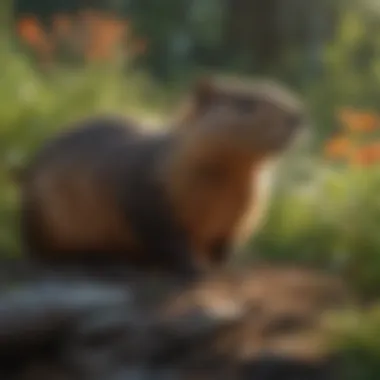
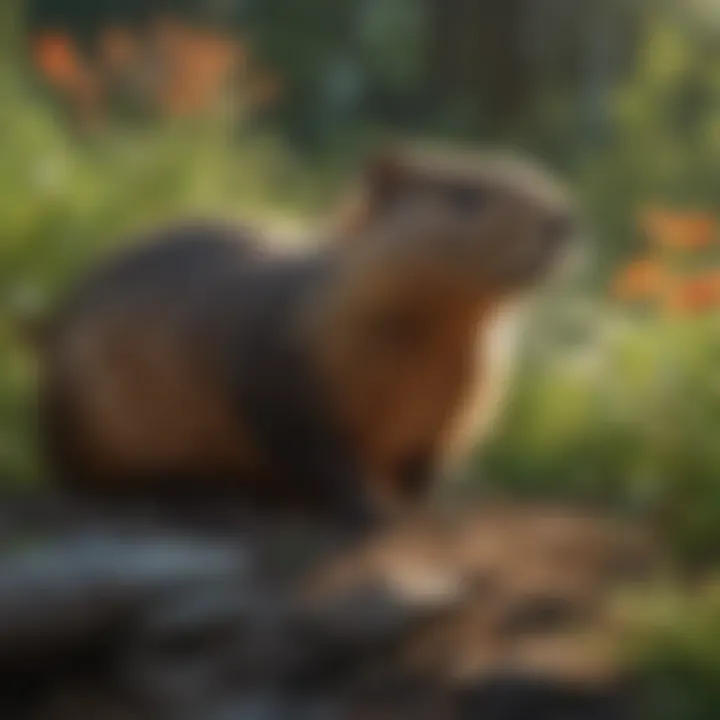
Intro
Woodchucks, also known as groundhogs, can be a troublesome presence in gardens and yards. Their burrowing habits and love for vegetables can lead to frustration for homeowners and gardeners alike. To manage these populations without causing harm to the environment, it is essential to understand their behaviors, habitats, and effective natural control methods. This section starts the exploration into the natural approach for woodchuck control, enabling readers to adopt sustainable practices.
Pest Identification
Detailed descriptions of common pests
Woodchucks (Marmota monax) are large rodents belonging to the squirrel family. Adults typically weigh between eight and twelve pounds and have stout bodies, short legs, and bushy tails. Their fur is usually a mix of brown and gray, providing effective camouflage in their natural habitat. They are herbivorous and favor a diet that includes clover, dandelions, and a variety of garden vegetables such as lettuce and carrots.
Signs and symptoms of infestations
Identifying a woodchuck infestation can be straightforward. Homeowners should look for:
- Burrows: Deep, wide holes in the ground about ten to twelve inches in diameter, often found in open areas or near gardens.
- Gnaw marks: Fresh bite marks on plants or vegetables, often seen on stems and leaves.
- Feces: Dark brown, rounded pellets that are often found near burrows or feeding areas.
- Tracks: Large paw prints measuring about two to three inches, usually left in soft soil or mud.
Being observant of these signs can facilitate early detection, allowing for timely intervention.
Prevention Strategies
Home maintenance tips for pest prevention
Maintaining a yard that is less inviting to woodchucks is crucial. Here are several practical approaches:
- Secure food sources: Store pet food and birdseed in airtight containers to minimize attractants.
- Vegetable protection: Use fencing that is at least three feet high and sunk into the ground to deter woodchuck entry.
- Clear clutter: Reduce hiding spots by regularly maintaining garden areas, such as trimming back overgrown plants and removing debris.
Natural deterrents and barriers
Incorporating natural deterrents can help keep woodchucks away:
- Strong scents: Sprinkling cayenne pepper or using garlic spray on plants can discourage feeding.
- Plants: Certain plants like marigolds and mint are known to repel woodchucks due to their strong aromas.
- Noise deterrents: Using wind chimes or motion-activated devices can create disturbances that may keep woodchucks at bay.
Treatment Options
Overview of chemical vs. natural treatments
When woodchucks become too persistent, understanding treatment options is essential. Chemical treatments may be effective but often carry risks to other wildlife and pets. Natural approaches are safer and more sustainable, aligning well with ecological principles.
Step-by-step guides for DIY treatments
One effective DIY treatment involves using a vinegar and water solution:
- Mix equal parts of vinegar and water in a spray bottle.
- Spray the mixture directly onto the plants that woodchucks usually feed on.
- Reapply after rain or watering.
This method creates an unpleasant taste for woodchucks while remaining safe for the environment and beneficial insects.
"Understanding woodchuck behavior and implementing natural control methods can lead to a pest-free garden without environmental harm."
By identifying the signs of woodchuck presence promptly and applying preventive measures, homeowners can achieve a harmonious balance in their landscape.
Understanding Woodchucks
Understanding woodchucks is crucial for effective control of their population. Many homeowners struggle with the presence of these animals in their gardens and yards. To manage woodchucks successfully, it is essential to grasp their biology, behavior, habitat preferences, and dietary habits. This insight fosters more effective uh-approaches for prevention and management.
Biology and Behavior
Woodchucks, also known as groundhogs, belong to the family Sciuridae and display behaviors that are adapted for their terrestrial lifestyle. Their body is stocky, typically weighing between 5 and 14 pounds, which helps them burrow effectively. Woodchucks are diurnal, meaning they are active during the day, typically in the morning and early evening.
Their behavior includes marking territory, often by chewing on plants or leaving droppings. This marking serves as a communication tool with other woodchucks. During spring and summer, males establish territories, creating a hierarchy within local populations. Understanding these behaviors allows homeowners to recognize when and where they are likely to find woodchucks.
Habitat Preferences
Woodchucks prefer areas with abundant cover and food sources. They are commonly found in woodland edges, fields, and gardens. Their burrows can be seen as mounds of dirt, often situated near fences or trees. These burrows provide protection from predators and a place for their young.
Regarding environmental preferences, woodchucks thrive in regions with plenty of vegetation. Gardens and agricultural landscapes often attract them due to the ample food supply. Knowing where woodchucks like to live helps homeowners create less inviting environments.
Dietary Habits
Woodchucks are herbivores, primarily consuming a variety of plants, fruits, and vegetables. Their diet includes leafy greens, clover, dandelions, and fruits like strawberries and raspberries. Understanding these dietary habits is vital for implementing effective woodchuck control measures.
A woodchuck's preference for gardens makes it essential for homeowners to monitor what plants they grow. For instance, protective measures should be put in place for gardens containing plants that woodchucks favor.
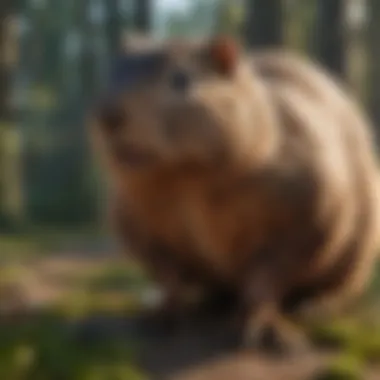
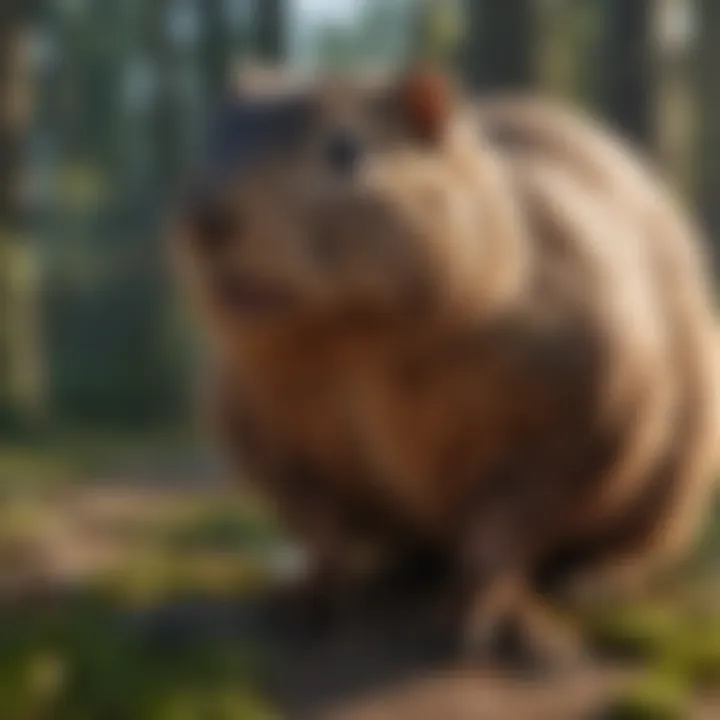
"By recognizing the specific habits and preferences of woodchucks, homeowners can make informed decisions on how to mitigate their presence effectively."
Ecological Impacts
Understanding the ecological impacts of woodchucks is essential for individuals looking to manage their populations naturally. This section highlights several key factors affecting the balance of local ecosystems, the role of woodchucks within them, and the implications of their behavior. Recognizing these elements helps to inform strategies that not only target woodchuck control but also promote ecological harmony.
Role in the Ecosystem
Woodchucks, also known as groundhogs, play a significant role in their ecosystems. They are primarily herbivores, consuming a variety of plants, which can contribute to plant diversity in their habitats. Their burrowing activity aerates the soil and promotes decomposition, facilitating plant growth. This behavior encourages a variety of organisms to thrive in the area. The holes they create can also become habitats for other small animals, thus contributing to the biodiversity of the environment.
"The role of woodchucks extends beyond their herbivorous diet; they actively reshape their habitat, influencing the ecological dynamics."
However, it is important to balance their presence. An overpopulation of woodchucks can lead to significant competition for resources among local flora and fauna. This can result in adverse effects on plant life, which may diminish food sources for other wildlife.
Impact on Gardens and Crops
While woodchucks hold ecological importance, their diet often includes many cultivated plants. This can create tensions between homeowners and woodchucks. They are known to cause damage to gardens, vegetables, and crops.
Common plants that woodchucks favor include:
- Lettuce
- Peas
- Carrots
- Beans
The impact on gardens can be substantial. Homeowners face not only the loss of crops but also the frustration of ongoing battles against these pests. This situation emphasizes the need for education in natural methods of deterrence that can coexist with woodchucks in their habitat.
Effective strategies can mitigate woodchucks’ negative influence on gardens. By adopting changes in gardening techniques and utilizing companion planting, homeowners can create a less inviting environment for woodchucks while still allowing them to contribute positively to their ecosystem. Keeping the natural balance is key in promoting both agricultural success and the health of local wildlife.
Identifying Woodchuck Problems
Woodchucks, or groundhogs, can create significant challenges for homeowners due to their burrowing habits and appetite for vegetation. Identifying problems related to woodchucks is crucial in managing their populations effectively and protecting your garden. Recognizing early signs of infestion can help you take measures before the damage becomes severe. Prevention and control can be more effective when you know what to look for.
Signs of Infestation
Woodchucks leave distinct signs that indicate their presence. Knowing these indicators can help you assess if you have a problem. Here are some common signs:
- Burrows: Look for holes in your yard or garden. These burrows are typically about 10 inches in diameter and can be near plants, trees, or the foundation of your home.
- Digging: Evidence of fresh digging around your plants or flower beds can also signal a woodchuck problem. This can include disturbed soil or overturned stones.
- Droppings: Woodchucks produce droppings that are about 1 inch long and dark brown or black. Finding these in your yard is a clear sign of their presence.
- Chewed Plants: If you notice unusual damage to your plants, especially those that are tender or young, woodchucks are often the culprits. They prefer green and leafy plants.
- Footprints: Look for paw prints in muddy areas around your garden. Woodchucks have five toes, and their tracks can help confirm their activity.
These signs can assist you in early detection and subsequent management of woodchucks.
Evaluating Damage
Once you suspect woodchucks are present, it is essential to assess the potential damage they cause. Evaluating the impact can help you decide on the best control strategies. Here's what to consider:
- Plant Damage: Take a close look at any plants that have been chewed or removed. The type of plants affected can give insights into what draws woodchucks to your property.
- Structural Impact: Burrows can undermine the stability of structures like patios and sidewalks. Inspect these areas for signs of erosion or collapse that may result from extensive tunneling.
- Comparing Areas: If you have multiple garden areas, compare damage across them. This can help pinpoint especially attractive zones for woodchucks and target them for management.
- Financial Costs: Consider the overall costs associated with replanting or repairing damages. Understanding the financial impact can also motivate you to take action.
By identifying signs of infestation and evaluating damage, you can implement more targeted and effective natural methods for controlling woodchuck populations in your yard.
Natural Deterrents Against Woodchucks
Natural deterrents represent an essential facet of managing woodchuck populations. As these creatures can be quite persistent and damaging to gardens and landscapes, implementing non-lethal methods aligns with ecologically responsible practices. By employing such strategies, homeowners can reduce woodchuck infestations without resorting to harmful chemicals or invasive techniques.
The effectiveness of natural deterrents relies on their ability to exploit the sensory preferences of woodchucks. Scents, physical barriers, and sound can be tailored to create an environment that encourages these animals to seek refuge elsewhere. When enforced, these methods not only guard valuable plants but also support a balanced ecosystem.
Scents That Repel
The use of specific scents can be an effective means to dissuade woodchucks from entering your garden. Strong odors that are unpleasant to woodchucks can be strategically applied around the perimeter of plant beds. Examples include garlic, hot pepper spray, and even ammonia. These substances disrupt the olfactory senses of woodchucks, creating an unwelcoming environment.
In practice, regularly renewing these scents will enhance their effectiveness. A scent that diminishes over time will fail to deter woodchucks as they acclimatize.
Physical Barriers
Physical barriers serve as one of the most straightforward and effective methods for deterring woodchucks. By creating obstacles that woodchucks cannot easily overcome, it is possible to protect prized plants. Each type of barrier offers unique characteristics and benefits:
Fences
Fences are a key element in woodchuck control. They are best when constructed with materials that discourage burrowing and jumping. A fence should be at least three feet high and buried at least a foot underground to prevent woodchucks from digging beneath. The use of wire mesh can be particularly effective.
The primary advantage of fences is their durability; once installed correctly, they can last many years. However, if not properly constructed, there can be gaps that allow woodchucks to enter, making diligent installation crucial.
Netting
Netting is another popular option. It can be draped over vulnerable areas, such as vegetable patches or flower beds. The lightweight nature of netting makes it easy to handle and adapt to various shapes and sizes.
A key characteristic of netting is its ability to provide physical protection without obstructing sunlight. Yet, one must ensure that the netting is anchored well; otherwise, strong winds may dislodge it, rendering it ineffective.
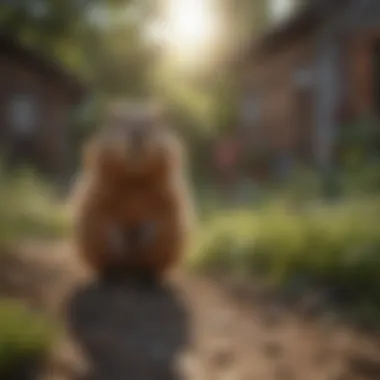
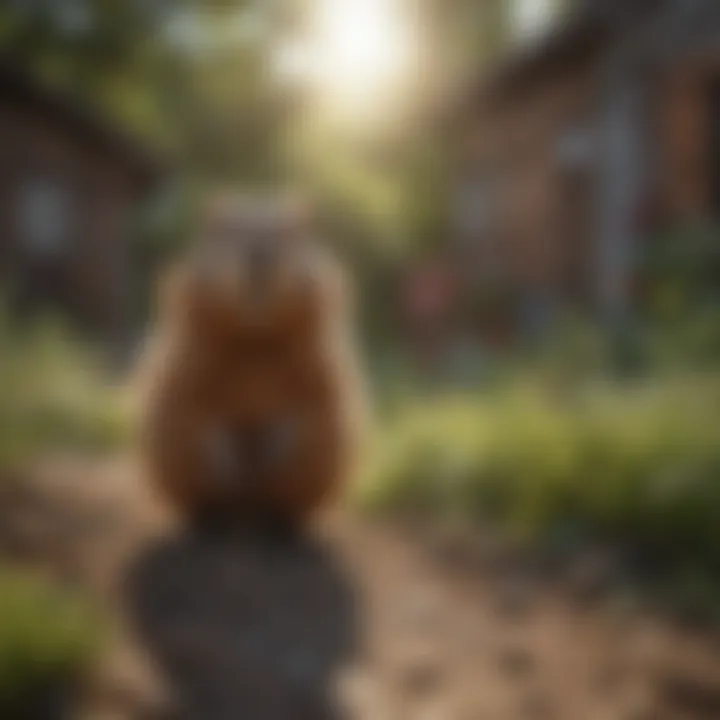
Ground Covers
Ground covers are an often overlooked strategy but can significantly contribute to natural woodchuck control. Specific plant varieties, such as clover or creeping thyme, can be planted to create dense ground cover. This method not only provides a barrier but can also enhance the aesthetic of the garden.
The unique feature of ground covers is their ability to make the environment less appealing to woodchucks as they prefer open spaces to roam. However, these plants need proper maintenance to ensure they do not become attractive to woodchucks as they grow.
Sound and Visual Deterrents
Sound and visual deterrents offer additional means of keeping woodchucks at bay. Noises, whether created by wind chimes or motion-activated devices, can disrupt woodchuck routines and deter them from approaching. Moreover, visual deterrents, such as reflective tape or plastic owls, can effectively create an unsettling environment for woodchucks.
Integrating a variety of sound and visual deterrents may provide the best results. It is crucial to understand that these strategies require regular repositioning or change to keep woodchucks from adapting to the stimuli.
Habitat Management Strategies
Habitat management strategies are crucial for effectively controlling woodchuck populations. These strategies focus on modifying the environment to make it less conducive for woodchucks to thrive. Not only do they help prevent infestations, but they also contribute to the overall health of the ecosystem. By understanding the habitat preferences of woodchucks and making intentional changes, homeowners can significantly reduce the likelihood of these pests damaging gardens and yards.
Landscaping Changes
Landscaping alterations play a key role in deterring woodchucks. By choosing plants wisely and designing the garden layout strategically, homeowners can create an uninviting environment for these animals. Taller plants should be limited, as woodchucks might use them for cover. Instead, incorporate shorter, denser foliage that does not provide easy access to hiding spots. Additionally, introducing prickly or thorny plants around the perimeter serves as a natural deterrent, making it less appealing for woodchucks to approach the garden.
Reducing Attractants
A significant part of woodchuck control involves reducing attractants in and around the yard. This encompasses any environmental factor that could draw woodchucks closer, including food sources and debris clutter.
Removing Food Sources
One of the most effective ways to control woodchucks is by removing food sources. This aspect is important because woodchucks are primarily herbivores and will seek out gardens for their sustenance. By eliminating the easy access to fruits, vegetables, and other plants, the likelihood of an infestation is greatly decreased. Key to this strategy is the removal of vegetable gardens during off-seasons. This makes the environment less favorable for woodchucks, causing them to search elsewhere for food.
The unique feature of this method lies in its simplicity. Homeowners can easily identify and take away potential food without substantial investment. However, while effective, there might be disadvantages in terms of the aesthetics of a garden. Removing certain plants does alter the visual appeal, yet the long-term benefits often outweigh these immediate concerns.
Cleaning Up Debris
Cleaning up debris is another fundamental aspect of habitat management. Proper maintenance of the yard reduces hiding spots and nesting areas, which woodchucks often utilize. Yard debris, such as leaves, branches, and unused furniture, can attract woodchucks by providing shelter. Regularly clearing away these materials not only makes the area less attractive for them but also contributes to overall yard health.
This method stands out because it fosters a tidy environment while deterring pests. Homeowners benefit by enhancing the garden's visual appeal and promoting growth for desired plants. However, it demands consistent effort, as keeping a yard clutter-free can be time-consuming. Still, its long-term effectiveness in reducing woodchuck presence makes it a worthwhile practice.
Utilizing Companion Planting
Companion planting plays a crucial role in natural woodchuck control. By strategically choosing plants that are either beneficial or detrimental to woodchucks, gardeners can create an environment that minimizes the pest's presence. This approach not only protects gardens but also promotes biodiversity and ensures healthier ecosystems. As woodchucks are drawn to specific plants, understanding their preferences can help in designing effective defenses. In addition to deterring these animals, certain plants can attract helpful insects, further enhancing the garden's resilience.
Effective Plant Combinations
Creating effective plant combinations is essential for maximizing the benefits of companion planting. Some plants work synergistically with one another, providing mutual benefits that can help in controlling woodchuck populations. For instance, planting marigolds alongside vegetables can deter pests with their strong scent while also attracting beneficial pollinators. Similarly, basil pairs well with tomatoes, as its aroma confuses plant pests. When establishing these plantings, consider native species as they are more likely to thrive in the local environment and support local wildlife.
- Marigolds
- Basil
- Cilantro
These plants are noted for their ability to mask the scent of vegetables that attract woodchucks, creating a less inviting garden. In addition, incorporating flowering plants such as sunflowers or zinnias can help attract predatory insects that may prey on woodchucks.
Plants That Deter Woodchucks
Certain plants have inherently repelling qualities that can deter woodchucks due to their smell or taste. For example, woodchucks tend to avoid herbs such as rosemary, sage, and thyme. These herbs not only contribute flavor in the kitchen but also serve a practical purpose in the garden.
Other notable plants include:
- Lavender: Its scent is known to repel woodchucks and other herbivores.
- Mint: Strong aroma can discourage woodchucks from coming near.
- Castor Bean Plant: While it’s important to handle this plant carefully due to its toxicity, it can act as a strong barrier against woodchucks.
Incorporating these plants into your garden layout can create a natural barrier. As a final note, always monitor how the chosen plants interact with your garden environment to ensure they thrive while effectively deterring unwanted pests.
"Utilizing companion planting can lead to a natural balance in your garden, creating a sustainable approach towards woodchuck control."
By thoughtfully selecting your garden’s plant combinations, you can work towards a woodchuck-resistant landscape that benefits all aspects of your home ecosystem.
Repellents and Homemade Solutions
Woodchucks can become a significant nuisance for homeowners, especially for those who cultivate gardens or manage landscapes. This section focuses on repellents and homemade solutions as effective and environmentally-conscious methods for controlling these rodents. Utilizing repellents, both commercial and DIY, can aid in deterring woodchucks from invading gardens without causing harm to wildlife or other beneficial creatures.
Commercial Repellents
Various commercial repellents are available on the market specifically designed to deter woodchucks. These products often contain natural ingredients or synthetic compounds that are unappealing to the senses of woodchucks. Some key benefits of using commercial repellents include:
- Effectiveness: Many commercial formulations have undergone testing, proving their ability to repel woodchucks effectively.
- Ease of Use: Most products come with clear instructions for application, making them user-friendly for busy homeowners.
- Quick Results: Users can often see results shortly after application, leading to immediate peace of mind regarding woodchuck presence.
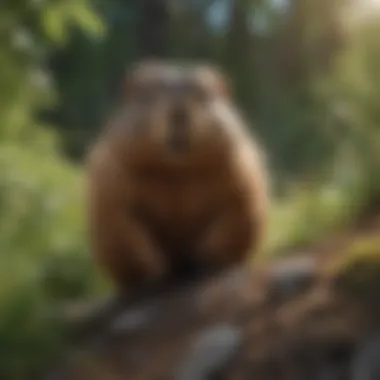
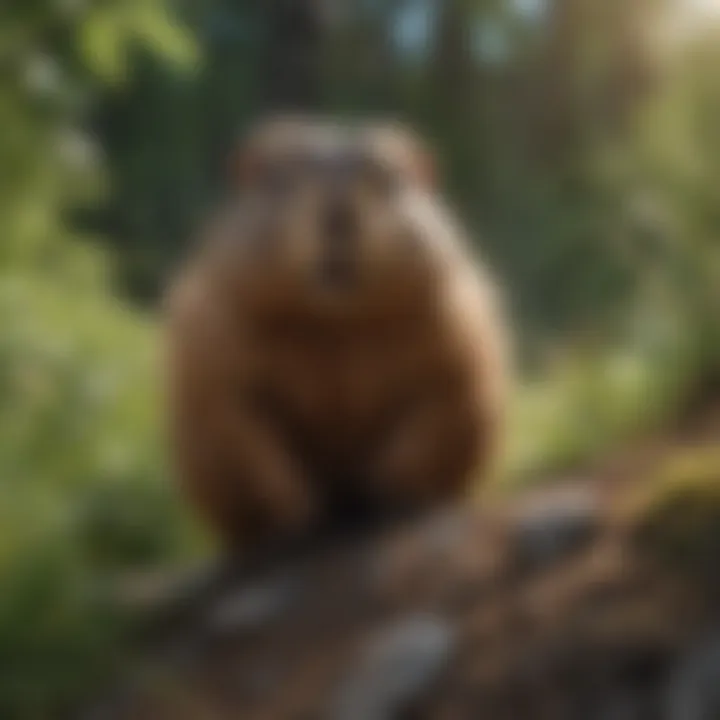
When selecting a commercial repellent, it is essential to read the ingredients list carefully. Choose products marked as safe for plants and the environment, reducing any potential negative effects on the ecosystem. Brands such as Critter Ridder and Nature’s Mace provide options that are widely recommended by pest control experts.
Always apply repellents following the manufacturer's instructions to maximize their effectiveness while ensuring safety.
DIY Natural Repellent Recipes
Creating homemade repellents can be a satisfying and cost-effective solution. Many households prefer DIY methods due to their natural ingredients that often have minimal impact on surrounding environments. Below are some effective recipes:
- Spicy Pepper Spray
- Garlic and Water Spray
- Scarecrow Solutions
- Ingredients: 1 tablespoon of cayenne pepper, 1 tablespoon of dish soap, 1 quart of water.
- Instructions: Combine all ingredients in a spray bottle. Shake well and spray around areas where woodchucks are active. The spicy scent is likely to deter them.
- Ingredients: 6 cloves of crushed garlic, 2 cups of water.
- Instructions: Steep the crushed garlic in water for several hours. Strain the mixture and spray around gardens and flowerbeds. The lingering odor is a natural deterrent.
- Ingredients: Old clothes, straw, and a pole.
- Instructions: Stuff old clothes with straw to create a scarecrow. Position it in your garden to scare away not only woodchucks but also other undesirable pests.
Using DIY recipes allows for customization, as ingredients can be adjusted according to one's preferences or availability. These natural repellents may not yield immediate results like commercial products but can be an excellent long-term strategy when combined with other control methods.
Integrating both commercial and homemade solutions into your woodchuck management strategy can enhance your success. Vigilance and regular monitoring are necessary to ensure that your selected methods remain effective. As with all pest control measures, consistency is key for achieving a balance in your garden.
When Professional Help Is Necessary
Identifying Severe Infestations
Severe infestations can result in noticeable damage to your property and landscape. Signs often include extensive burrowing, significant plant damage, and even structural issues around your home. Here are key indicators:
- Multiple active burrows: A sign that several woodchucks are living in your yard.
- Frequent sightings: Regularly spotting woodchucks during the day or at night.
- Excessive feeding: Evidence of large amounts of plant material being consumed.
- Damage patterns: Looking for specific plants known to be favorites, which could indicate targeted feeding.
If you observe these signs, it is essential to assess the extent of the issue. Ignoring severe infestations can lead to more extensive damage, making it more challenging to resolve independently.
Choosing A Pest Control Service
When the situation calls for professional help, selecting the right pest control service is vital. Consider these points:
- Experience and Specialization: Look for a service that has a solid track record specifically with woodchuck control.
- Approach and Methods: Ensure they adopt humane and environmentally-friendly practices, aligning with your natural control goals.
- Reputation: Research reviews and testimonials. Reliable companies should have positive feedback from previous clients.
- Cost Estimates: Request quotes from multiple services. Understand the pricing structure and what it includes.
- Follow-Up Services: Inquire whether they offer ongoing management options to prevent future infestations.
"Choosing a pest control service is an investment in the health of your property and peace of mind."
By focusing on these aspects, homeowners can find professionals who will address woodchuck issues effectively while maintaining a commitment to sustainability.
Legal Considerations
When addressing woodchuck control, understanding legal considerations plays a vital role in ensuring effective and responsible management of these animals. Laws surrounding wildlife can vary significantly across regions. Compliance with these laws is essential not only to avoid penalties but also to promote ethical treatment of animals.
It is crucial for home owners and gardeners to familiarize themselves with local regulations related to woodchucks. This ensures that any control methods used comply with legal standards. Ignoring these laws can lead to unwanted legal trouble, including fines or mandatory reporting of wildlife issues. Ultimately, awareness of legal considerations helps in developing strategies that are not only effective but also humane.
Understanding Local Laws
Local laws dictate how individuals can manage wildlife populations. In many areas, woodchucks are classified either as pests or under wildlife protection laws. Some jurisdictions allow lethal measures for pest control, while others impose strict guidelines on how wildlife can be handled. A thorough understanding of these laws aids in determining what methods are permissible.
To achieve compliance, it may be beneficial to reach out to the local wildlife agency for guidance. They can provide resources about regulations that impact your situation. Furthermore, understanding these laws can also help homeowners protect their property legally.
"Awareness of legal implications surrounding wildlife ensures both effective pest management and ethical treatment of animals."
Regulations on Wildlife Control
Regulations concerning woodchuck control often focus on humane treatment and conservation. Many regulations recommend non-lethal methods of control, emphasizing the use of natural deterrents, habitat management, and environmentally friendly solutions. Some states require permits for capturing or relocating woodchucks, highlighting the necessity of approaching wildlife management thoughtfully.
Homeowners should also be aware of any progressive programs available for wildlife population management in their area. These programs often emphasize collaboration with environmental organizations or local governments.
In summary, understanding the distinct legal landscape surrounding woodchucks ensures that control efforts are not only effective but also compliant with regional norms. This comprehension ultimately contributes to a balanced approach to pest management that respects both the environment and the local ecosystem.
Monitoring and Assessment
Monitoring and assessment are essential components in the effective control of woodchucks. These practices help determine the success of implemented strategies as well as identify changing dynamics in the woodchuck population. Without these processes, it becomes difficult to evaluate whether efforts made are productive or if adjustments are required. Regular monitoring allows homeowners to gather data on woodchuck behavior, locations, and activity levels that can inform future actions.
Evaluating Control Success
Evaluating control success involves tracking the effectiveness of the methods employed against woodchuck populations. This can include several approaches:
- Observation: Regularly watching for woodchuck activity can signal whether the population is diminishing or staying the same. Noticing a decrease in sightings can indicate effective deterrents.
- Damage Assessment: Take note of any new damage to gardens or property. A decrease in visible damage might suggest that control measures are working.
- Sign Review: Look for signs such as burrows or droppings. Fewer signs typically show better control.
Documentation throughout this process can provide valuable insights on what approaches work best. It can also shed light on new problems occurring over time.
Adjusting Strategies Over Time
Adjusting strategies over time is critical as woodchucks may adapt to deterrents. As monitoring progresses and data is collected, one needs to be cautious about stagnation in methods. Each region may have unique factors influencing woodchuck behavior that can shift over time;
- Change in Diet: Woodchucks may alter their food sources based on availability. Modifying planting strategies or applying new repellents may be necessary.
- Physical Barriers: Fencing and other barriers may become less effective if not maintained. Regular checks are needed to ensure they remain intact and functional.
- Pest Population Dynamics: Fluctuations in the surrounding ecosystem may impact woodchuck populations. Understanding these changes can lead to adjustments in strategy that optimize control efforts.



